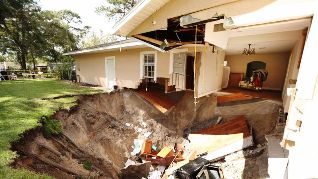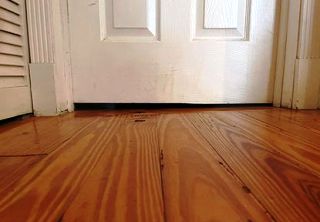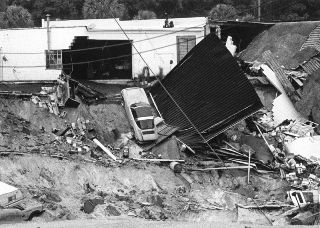Just days after the
collapse of the condo tower in Surfside, an obscure study
emerged that the building had been sinking into the earth
for years.
It remains unclear whether the settling, or subsidence, of
Champlain Towers South was a factor when the 12-story
building crumbled to the ground in the middle of the night
on June 24, killing 98 residents. But the phenomenon of
subsidence occurs throughout South Florida and has been
implicated in damage to structures, especially houses, from
Key West to Palm Beach.
|
A home at 222 West Kelly Park Road in Apopka is swallowed by a sinkhole on Sept. 19, 2017. The sinkhole is a result of Hurricane Irma. In South Florida, where sinkholes are rare and smaller than those to the north, subsidence is more gradual. When it takes place unevenly, with one side of a building settling faster than the other, it can crack floors, distort window frames and generate lawsuits over insurance coverage. |
Subsidence has damaged the home of Surfside’s former mayor. In Parkland, about a dozen homes required foundation repairs from subsidence in the past three years. In Palm Beach Gardens, sinking earth cost Constance Bonvechio her house, cracking the ceiling and foundation, and leading to a lawsuit against her insurance company.
“If the decision [of the court] was a sinkhole, I was covered for it,” Bonvechio said, “But I was not covered for organic matter.”
The damage to
Bonvechio’s home wasn’t from a sinkhole. Bonvechio says
inspectors drilled for sinkholes at least five times. The
last time, “they went with an auger underneath the garage
where the main problem seemed to be.”
They found pine trees, she said. “There were pine trees
decomposing under the house,” causing subsidence.
Bonvechio and her insurance company ultimately settled the
case for an undisclosed amount in January 2013, court
records show. Unable to afford the cost of repairs.
Bonvechio sold the house for its land value.
|
The house of Daniel Deitch, former mayor of Surfside, is settling. The subsidence has led to an uneven door. |
“What happens is the guys didn’t do the preparation of the soil by the compaction methods that can be used or they did it half-baked,” said Richard Slider, president of Slider Engineering Groups of West Palm Beach, who investigates the causes of building damage.
That leaves homes with concrete slab foundations placed directly on the soil vulnerable to incorrectly prepared land.
“As a result [of the subsidence], it causes this differential settlement,” Slider says, “and that’s what causes the problem. If the house is settling three-quarters of an inch on one side and a half-inch on the other, that’s a problem because the house wants to bend or break, and that’s what causes the cracks.”
|
In 1981, a sinkhole in Winter Park opened up gulping down 250,000 cubic yards of soil, five Porsches at a foreign car repair shop, the deep end of an Olympic-size swimming pool, chunks of two streets and a three-bedroom home. Picture taken May 11, 1981. |
“This is normally due
to the ground under the slab drying and shrinking over
decades.” he said, adding that the houses typically settle
in only a ½- to 1-inch range. Engineers sometimes repair the
slab using pressure-injected foam that levels the
foundation, according to documents provided by Tracy.
But getting an insurance company to pay to fix the
foundation is another matter entirely.
‘Cautious homeowners’ need multiple insurance plans
Florida’s homeowner insurance regulations often can leave
people with a sinking feeling when they realize that uneven
subsidence — and even full-on sinkholes — might not be
covered.
Now, if you want to protect your home from subsidence you
have to purchase extra insurance.
That’s because Florida law once required homeowners
insurance to provide sinkhole coverage, but not coverage for
subsidence. Today, it covers only “catastrophic ground cover
collapse.”
By about 2010, sinkhole claims across Florida were rising.
So in 2011, Florida’s Legislature altered the law to
restrict payouts for sinkhole claims to only the most
catastrophic cases. That meant that many people whose homes
were merely damaged by subsidence in Southeast Florida were
often not eligible for payouts.
Stephen Marino, managing partner of Ver Ploeg & Marino, a
Miami law firm that represents insurance policy holders,
said insurance companies have spent years carving out
exceptions to homeowners coverage to reduce their costs.
Now, if a homeowner wants coverage for a specific risk like
a flood or a sinkhole, they have to buy it separately, he
says.
PIC In 1981, a sinkhole in Winter Park opened up gulping
down 250,000 cubic yards of soil, five Porsches at a foreign
car repair shop, the deep end of an Olympic-size swimming
pool, chunks of two streets and a three-bedroom home.
Picture taken May 11, 1981. (Red Huber, Orlando Sentinel
file)
“In Florida, to be a fully covered homeowner in certain
parts of the state, you now have to have a property
insurance policy for liability coverage, a windstorm policy,
a flood policy and a sinkhole endorsement or separate
sinkhole coverage,” he said. “Florida is treated differently
than other states because a cautious homeowner has to buy
four separate insurance policies for the same structure.”
Not a lot of people do, says Paul Handerhan, president of
the Federal Association for Insurance Reform, a
consumer-focused watchdog group.
“The broader coverage is more expensive, and I don’t believe
many people purchase it,” he said.
One reason might be the high deductibles.
Friedlander, from the Insurance Information Institute,
points out that optional sinkhole coverage has deductibles
set by law at either “1%, 2%, 5% or 10% of the property
dwelling limit. So, if your home’s dwelling limit is
$300,000, and you have a 5% deductible, the deductible would
be $15,000 before a claim payout is made by your insurer.”
In 2010, sinkhole damage claims in Southeast Florida almost
doubled, data from the Florida Department of Insurance
Regulation shows. Between 2006 and 2009, Miami-Dade and
Broward accounted for only 2.9% of all sinkhole claims
state-wide. In 2010, the two counties accounted for 4.2% of
all claims statewide.
Hernando, Pasco, Hillsborough, and Pinellas counties, known
as “the sinkhole belt,” accounted for well over 85% of all
sinkhole claims in and payouts in the early 2000s.
The 2011 laws also had predictable effects. In one 2017
lawsuit out of West Kendall in Miami-Dade, a judge found in
favor of an insurance company simply because the house in
question had not collapsed — even though the insurance
company recognized that the “cause of distress to the
property is related to non-engineered fill causing
settlement of the soils which caused damage to the home,”
court records read.
But not all sinkhole claims go unpaid.
“I myself have 30, 40 claims in the Hollywood area, in the
Plantation area, South Miami area, where the engineers for
the insurance companies have confirmed sinkhole activity,”
says Howard Levine, an attorney who has represented Broward
homeowners in sinkhole cases against insurance companies.
Rarer in larger buildings, but possibly more dangerous.
Subsidence has affected at least one other large building in
the area. In downtown Miami, the opening of the 47-story
building now called Miami Tower was delayed in 1988 after
the building sank 5 inches on one side, disrupting the
operation of its elevators. Engineers had to remove and
reinstall the elevators after the building finished settling
into its foundation.
In Surfside, the Champlain Towers building sank at a rate of
about 2 millimeters a year in the 1990s, according to a
study by Florida International University professor Shimon
Wdowinski.
“Two millimeters per year is usually not a big threat,”
Wdowinski said, unless the building was subsiding unevenly,
though the data from his study cannot speak to that.
Wdowinski used satellite data to determine that the building
itself was sinking. He also detected small pockets of land
subsidence that were distributed along the western area of
Miami Beach, a part of the city that was historically built
on fill dredged from the bottom of Biscayne Bay.
But it appears that the Surfside building may have lacked
design elements intended to prevent it from settling
unevenly, say two independent civil engineering experts who
reviewed the building’s plans.
Like most large structures in Florida, Champlain Towers
South was built on piles — long concrete rods sunk or
pounded deep into the earth that hold the building up in
soft or mushy soil.
Atorod Azizinamini, dean of the Department of Civil and
Environmental Engineering at Florida International
University, says that the plans for the Surfside building
lacked any indication that its support pilings were
connected by grade beams, which can tie them together and
prevent them from settling at different rates.
Mohamed W. Fahmy, a lecturer in engineering at the
University of Miami who also runs a structural consulting
firm, concurs with Azizinamini’s analysis about the
building’s vulnerability to lateral movement caused by
differential subsidence.
He points out that the building’s foundation — an almost
foot-thick slab of concrete laid around all the piles — does
not have rebar connecting it to the piles at both its top
and bottom.
Both Fahmy and Azizinamini said that the design elements
lacking from the building don’t prove that uneven settlement
actually took place, just that the building lacked an
element designed to prevent it.
“You’re going to find out many factors played a role in this
thing,” Azizinamini said. “Not just one.”
Allyn Kilsheimer, the engineer hired by the Town of Surfside
to investigate the collapse, is skeptical of theories that
the building was vulnerable to differential subsidence.
“We’ve done close to a thousand buildings that we have on
piles. We don’t have grade beams in any of those,” he said.


